The Grand Wyndham Berlin Hotel wifi situation turned rancid for a lot of people here yesterday afternoon. Zero page loads or loading speeds so slow they barely merit the name…no action. I don’t know why I didn’t notice the problem then but I definitely noticed it today. It was working, not working, working, etc. I was given a new restricted password and it worked for a while, and then chaos again. I did what any mild-mannered professional would do in this situation. I made the people who are administratively responsible suffer. Bad wifi makes me see red. I become Nick Fury. It’s funny but on some level I almost enjoy raising persistent hell when this happens. Well, I don’t actually “enjoy” it but once I give myself over to a Shohei Imamura Vengeance Is Mine mindset, I feel like I’m in some kind of groove. Anyway, the “air” is now working again, and for good measure the hotel manager gave me a couple of ethernet cables for direct connectivity. I guess I’ll be okay but my hotel wifi motto still stands. Bring internet anguish into my life and I will double if not triple it before sending right back into yours.
Winterbottom’s Amanda Knox Drama
Based on a non-fiction work by Barbie Latza Nadeau, The Face of An Angel is Michael Winterbottom‘s roman a clef about the Amanda Knox murder trial. A filmmaker (Daniel Bruhl) is hired to make a movie about a high-profile murder case involving an American female exchange student living in Italy who’s been convicted of killing her roommate and her boyfriend, etc. Kate Beckinsale co-stars as a reporter who’s also working the same story (i.e., presumably based on Nadeau). Pic is currently shopping for a distributor.
Berlin Bump
Last night Fox Searchlight publicists invited Grand Budapest Hotel junketeers to a bar lobby reception at Berlin’s Hotel Adlon Kempinski. Soothing vibe, pretty waitresses, pleasant surroundings. The Adlon was one of the great world-class luxury hotels in the early to mid 20th Century, but most of it was destroyed by Allied bombings near the end of World War II. A plush nouveau-riche imitation was built in the mid ’90s — nice but the architectural signature is 21st Century ersatz. Around 9 pm I noticed Wes Anderson, Tilda Swinton, Willem Dafoe and other Grand Budapest Hotel creatives exiting the Adlon elevator. They didn’t wave or stop to chat, but no worries. Thelma Adams and I walked back to our hotel — a nice 25-minute stroll. Grand Budapest Hotel will press-screen today around noon and open the Berlin Film Festival this evening. I lost my ticket due to changing my hotel room inside Berlin’s Grand Wyndham Hotel twice since late last night — insufficient heat, spotty wifi, a light that wouldn’t turn off, a tub/shower that drove me crazy. I’m now in a nice spacious suite. The squeaky wheel always gets the grease.
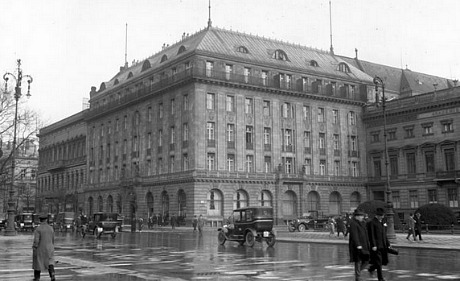
The current Adlon Kempinsky Hotel bears only a superficial resemblance to the old classic Hotel Adlon (pictured here in 1928).

The present-tense, nouveau-riche version of the Hotel Adlon.

The Brandenburg Gate is only a block or so from the Hotel Adlon.
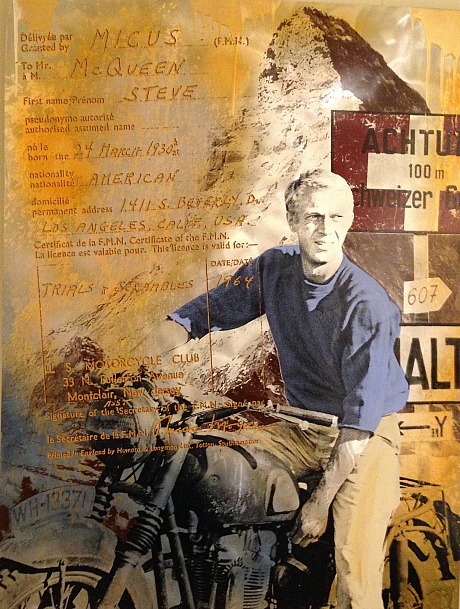
Wyndham Wifi Is Brilliant
I couldn’t be in a better mood. I napped for about 90 minutes on the British Airways flight from Heathrow. I ran into David Poland (whose luggage was AWOL) and Thelma Adams at Berlin’s Tegel Airport. A nice easy drive into the city. Now I’m all checked in and unpacked at Berlin’s Wyndham Grand Hotel. A pair of Fox Searchlight publicists met me in the lobby and gave me my Berlinale press pass. The room is small (not quite as roomy as a Motel 6 suite in Billings) but nice. The high-def TV works really well, the hotel concierge has lent me two power adaptors (the one I bought at Heathrow doesn’t work for a three-prong) and the hotel wifi is double-lightning fast…to die for! Now I’m off for a 90-minute walk. A Fox Searchlight press reception is happening at 7:45 pm.
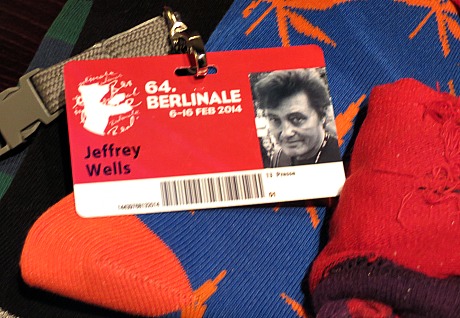
Gleaming Cue Ball
Gene Hackman looked a bit lame when he wore a bald cap to play Lex Luthor in the 1978 Superman, and Jesse Eisenberg, I predict, is going to look even dopier when he plays baldie Lex in Zack Snyder‘s Batman vs. Superman flick. How many actors have looked cool with shaved heads? Ben Kingsley, Bruce Willis, Yul Brynner and who else? Eisenberg should keep his wiggy Zuckerberg look. Who cares? What, he has to play the part bald because Lex Luthor was drawn that way decades ago? What’s the difference? If you’re truly creative, you can do anything you want. Eff D.C.Comics tradition. Break on through to the other side.
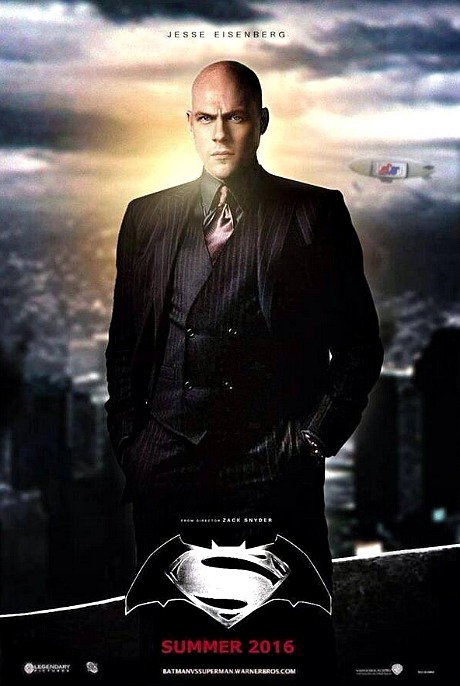
Sleeper
Last night’s British Airways flight from JFK to Heathrow was 35% to 40% full, if that. I had an entire middle row to myself so I stretched out on the floor for some zees. Three pillows, three blankets. Not very comfortable (I slept maybe two and a half or three hours) but simply lying flat was wonderful. My legs were delighted. I’m going to remember this henceforth — always fly British Airways redeye to London on Tuesday. In ’83 or ’84 I had an entire middle row to myself — I put up the armrests and laid across four seats — perfect. In the ’30s and ’40s airlines used to have sleeper cots with curtains in first class.

Heathrow Airport — Wednesday, 2.5, 8:40 am.

Blanchett Is No Dummy
The Santa Barbara Holiday Inn wifi was so weak this Cate Blanchett award-acceptance video (taped last Saturday night) wouldn’t upload. I managed to get it on YouTube during my brief turnaround in West Hollywood before heading for LAX yesterday morning. You’ll notice that Blanchett thanked her Blue Jasmine costars but not the writer-director. Totally understandable. I would have done the same. Note: Blanchett’s SBIFF interviewer Pete Hammond reminds that she spoke admiringly of Allen during their on-stage chat, but that was due to Hammond raising the subject.
A Nice Shocker Or Two
“And the Oscar goes to…(tear, rip, shocked expression)…oh, God…the Oscar, ladies and gentlemen, goes to someone that Scott Feinberg and Michael Musto were predicting to win but which almost everyone else felt was a long shot, at best!”
All I want from the 3.2 Oscar telecast is an upset. I want someone to win that most of the Gurus of Gold and the Gold Derby gang never saw coming. One would be nice, two would be better.
Punishing Cate Blanchett for the Woody Allen contretemps is absurd, but a part of me will be delighted if Amy Adams takes the Best Actress Oscar from her. Because upsets are exciting!
I know Leonardo DiCaprio isn’t going to win the Best Actor Oscar but if he does (because he effing deserves to, because his Wolf of Wall Street performance is landmark)….well, okay!
What upsets are at least a bit more than possible? Which ones might actually happen? I’m asking.
[My British Airways flight is about to take off from JFK as we speak. Six hours of wifi flatlining await.]
Get Outta Town
Since the Dylan Farrow letter was published people have noted an inconsistent posture on Mia Farrow‘s part — condemning Woody Allen for allegedly abusing Dylan as well as cradle-robbing Soon-Yi but being a friend and supporter of Roman Polanski, who’s had similar mud thrown his way. Two days ago Farrow tweeted that she’s “not” Polanski’s friend. Really? Pop in the Criterion Bluray of Rosemary’s Baby (released on 10.30.12) and watch the “making of” documentary, in which Farrow speaks very admiringly of Polanski’s method and artistry in the directing of that 1968 film. Maybe they don’t converse regularly and have dinner every other week, but Farrow is obviously in RoPo’s corner. What, did she change her mind after taping her interview? The proof is in the pudding.
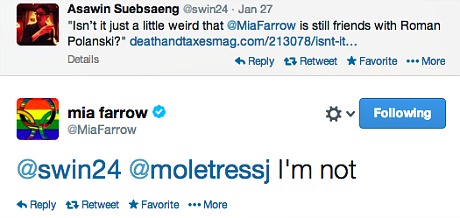
Appealing To LexG Crowd
This morning a Hollywood Reporter/Scott Feinberg piece appeared about Paramount’s “It’s Awesome!” billboard on behalf of The Wolf of Wall Street. Obviously this isn’t intended to reach Academy voters who might be dithering about whether to vote for Gravity or 12 Years A Slave or American Hustle. Okay, maybe it is but it seems aimed at the “too shallow to get it” crowd. — i.e., .the popcorn-munchers who have been enjoying Martin Scorsese‘s film for “the wrong reasons.” If it was my call I would have had the poster say “It’s Effing Brutal!” Meaning, of course, that it uses Jordan Belfort‘s saga to characterize the one-percenters and the Wall Street community as contemptible thieving pigs. Three other Wolf billboards praise the film in a more traditional fashion, calling it “The Movie Of Our Time,” “Bold Brave Classic” and “His Best Performance Ever.”


Half Century Passes Swiftly
“No aspect of the Beatles first U.S. visit looms larger in legend than their initial appearance on The Ed Sullivan Show, a performance (actually two performances, since Sullivan was cagey enough to put them on at both the beginning and the end of the program in order to keep the audience tuned in throughout) witnessed by an estimated 73 million television viewers — about 38% of the entire U.S. population at the time. Legends that large often spawn their own sub-legends, in this case the claim that the Beatles so transfixed and charmed their youthful audience that the entire teenage population of the U.S. remained on its best behavior for that one hour, and not a single hubcap was stolen anywhere in the country between 8:00 PM and 9:00 PM on February 9, 1964.
Dodged A Bullet
“Now that [Phillip Seymour Hoffman] is gone, much has been said about his failure, about his fall,” writes N.Y. Times columnist David Carr in a recent post. “I don’t really see it that way. He got in the ring with his addiction and battled it for two decades successfully, doing amazing film work for years and doing the hard stuff to keep ambitious theater alive in in New York.
“And then something changed and he used. Everyone is surprised when that happens to someone famous, but it happens routinely everywhere else. Rooms of recovery are full of stories of people with long-term recovery who went back out and some of them, as a matter of mathematics and pharmacology, don’t make it back.
“I have no certainty about what went wrong, but I can tell you from personal experience that what happened was not the plan. I have been alone in that room with my addled thoughts, the drugs, and the needle. Addicts in the grip always have a plan. I will do this, get this out of the way, and then I will resume life among the living, the place where family, friends and colleagues live. He didn’t make it back to that place.”

